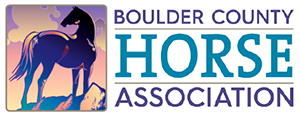By Jean West-Watanabe
The natural training approach to equine behavior has highlighted many new things about horses and their innate behaviors and instincts. One of those behaviors is that horses will store pain and stress in their bodies, learning to block pain out mentally so as not to show signs of weakness. Both domestic horses and their wild relatives are as inclined to do this for as long as they can, because they are prey animals and weakness can often mean death. It’s the very thing that predators look for when stalking herd animals. Horses will avoid showing weakness even in the comfort of their own backyards or barns. By the time a horse eventually favors a limb, leg and neck flexion have been compromised, the problem has reached an intolerable stage of pain and stress, and attention is needed immediately. What most people don’t know is that the stress and pain have already been stored there for quite some time, and early intervention can be helpful in preventing performance issues.
The Masterson Method is becoming a nationally known therapy for innovative bodywork and is excellent in releasing this stored pain and stress for a better performance horse. It all began in 1997 in Fairfield, Iowa, where Jim Masterson, the renowned equine bodyworker for USET Endurance Teams, FEI World Cup and World Games competition horses, began to take interest in Equine Massage. Jim noticed that horses would show neurological responses to light touch, releasing tension and stress from their body. Deep eye blinks, quivering lower lips, a glance back, or merely a shift in weight are a few of the responses he began to look for. These responses correlated directly to the touch he was doing. From this early observation he slowly pieced together his own method of bodywork, using the best features of several alternative therapies and incorporating them into one comprehensive system.
The Masterson Method incorporates Reiki, which connects the energy from your body to meet your horse’s energy; massage for stimulating the lymphatic fluid which helps the immune system and damaged tissue; acupressure to stimulate the meridian pathways to all of the major organs of the body; and stretching and rotation of limbs to release tension and stress. Most importantly, it is the detailed focus on the horse’s responses as pain and stress are located throughout their body, which really sets the Masterson Method apart from the rest.
There are three key junctions in a horse’s body that can disrupt or enhance their attitude, performance and mobility:
– the poll/neck junction
– the shoulders/withers junction
– the sacro/lumbar junction
The Masterson Method focuses on these areas, using the horse’s subtle responses and reaction to touch to indicate where pain and stress are being stored. Once the trouble area has been located, the Masterson Method technique is unique in its ability to release this tension and pain—all with the horse’s cooperation. When a spot filled with tension and pain is stimulated by touch, the nervous system has to release it in some way. Patience, timing and attention to detail are essential in the Method’s ability to draw out the stress and pain from even the most reluctant of horses. The horse’s releases may start out subtly and may slowly build and become more pronounced, sometimes continuing for hours after the therapy has been done. Licking/chewing and yawning are some of the more subtle signs as endorphins are being released. Head or body shaking, snorting, and passing gas may be intermediate responses. The most noticeable and largest releases are fidgeting, pawing, biting at their body or lead rope, kicking out a leg to the side, and changes in breathing.
With the world of horsemanship ever-changing as we gain more insight as to how our animals actually think and perform, and how their bodies truly work, the Masterson Method offers a natural approach to working with the horse. Jim Masterson has joked when asked if this technique is just a bunch of mumbo jumbo. His response? “Well, it might be, but it works!”
BCHA would love to know if you are interested in a FREE seminar for members on this topic. Please send us your comments to this post and we will try to get one scheduled.
